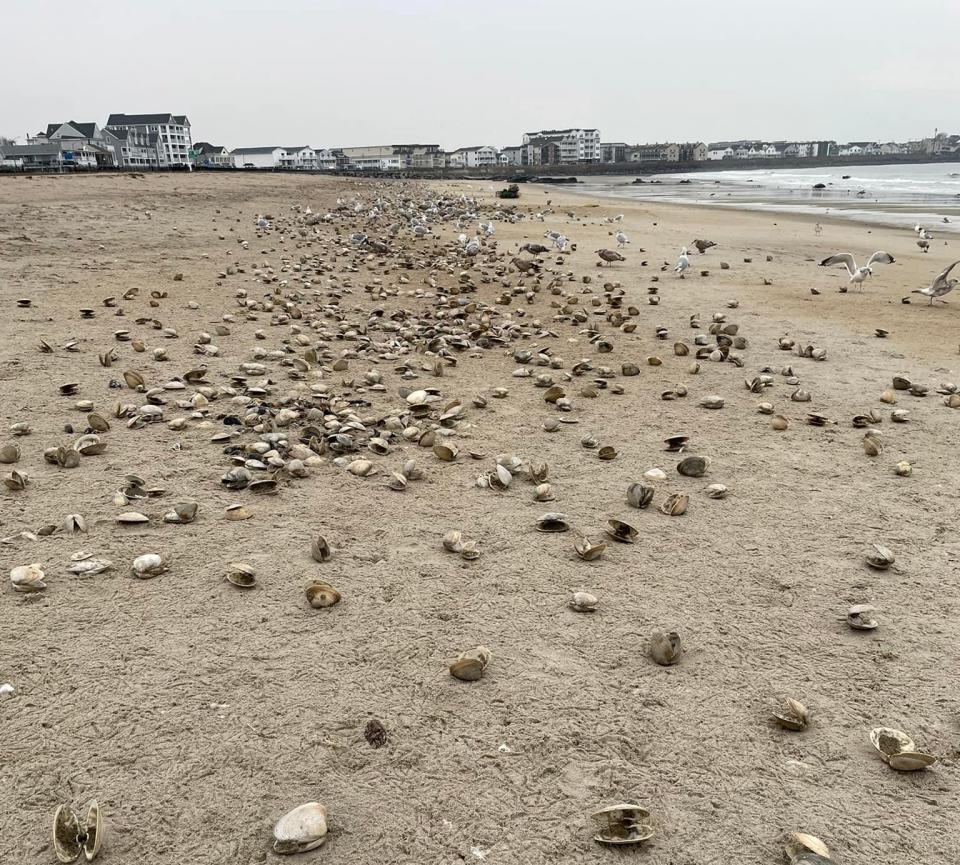Hampton Beach was awash in surf clams after storm: Here’s what you need to know
HAMPTON BEACH — One of the great advantages to living along the ocean are the amazing things that show up on the beach after a storm. We often forget that there is a whole world under the ocean waves that we only get a glimpse of when the tides and storm surge deposits them on our shore.
During the last storm, if you took a stroll in the frigid temperatures along Hampton Beach, you would have found thousands of Atlantic surf clams that had been tossed up from the storm surge. The seagulls and shore birds were having a feast.
18 inches of snow?: Blizzard warning for Seacoast NH, southern Maine: What you need to know

Most of them were empty shells but unfortunately, any clams still living were most likely fast frozen by the extreme temperatures and soon eaten by the marauding birds. Everything has to eat!
Rare rescue attempt: 600-lb. bottlenose dolphin found in Rye dies. What you should know.
Surf clams (Spisula solidissima), sometimes referred to as sea clams, occur from Cape Hatteras, North Carolina to Atlantic Canada. Until modern times they were harvested only as bait for recreational fishing to catch cod, haddock, and flounder with a rod and reel. Rumor has it that the restaurant chain Howard Johnson’s developed clam strips from Atlantic surf clams in the 1950s to sell in their restaurants as a cheaper source of clams.
‘It was quite a scene’: Hampton Beach dries out after winter storm floods
Since then, they have been harvested for food and sold around the world.
Surf clams are usually harvested when they reach about 5 inches in width (Federally). They are sexually mature at 1-2 years and can live up to 35 years of age, according to NOAA Fisheries. Each spawning season in the spring these clams release thousands of eggs or sperm into the water column. This process is called broadcast fertilization and produces planktonic larvae for the bottom rung of the ladder in the ocean’s food chain.
Do not eat surf clams that wash ashore
Now please do not get any ideas about harvesting them yourself for your chowder or fried clams. Clams, as with all bivalves (animals with two shells) are what scientists refer to as filter feeders.
They have two siphons; one pulls water into their body and filters particles to eat. The other pushes the filtered water back out into the water column. Surf clams feed on algae, diatoms and other tiny plankton.
Unfortunately, they also filter out contaminants from the water that are dangerous for human consumption. These contaminants can include coliform bacteria (from human and animal waste), and dangerous, poisonous animals called dinoflagellates, which cause red tide and paralytic shellfish poisoning in humans and other animals.
Blue crabs at Hampton Beach: Can you take them home for dinner? Just don't get pinched
They can also filter out many other harmful contaminants. Clams are a great asset to the ecosystem as they can purify the water of contaminants for the rest of the living organisms. The problem with this is that they absorb these contaminants into their body tissue, and it can concentrate to the point where the animal becomes toxic if eaten by humans.
This does not mean that the clams you buy as clam strips in the restaurants or grocery store are harmful in any way. The surf clams that we eat are actually not found in the surf, they are harvested in the coarse sandy bottom from just outside the intertidal zone (low tide line) to about 160 feet. This occurs primarily from southern Massachusetts to Virginia. There currently are not any commercial harvesters of surf clams in New Hampshire state waters for food. Should someone apply for a commercial permit, the clam beds would have to be delineated and monitored to ensure food safety. In other states, there are facilities that allow the testing for contaminants.
Nature News: How to identify a mystery fish (or anything in nature)
Other clams found along the shore
The other clams that are found along the shore are called soft-shelled clams. While there is not a commercial harvest of these clams in New Hampshire, there is a recreational harvest. The season for this is determined by the state testing of the harbor water for contaminants and the amount of rain that occurs. Scientists have also developed a way to make sure the contaminants are removed from the commercially harvested soft-shelled clams. This process is called depuration; it is a time-consuming process, but it also uses the clams’ natural filtration to remove the contaminants. We do not have any of these depuration plants in New Hampshire.
Surf clams are great for bait
The state of N.H. does allow harvesting surf clams to use for bait by residents only in specific open areas which includes Hampton Beach. There is no limit on the size or number of Atlantic surf clams that you can harvest recreationally but a permit (N.H. residents only) is necessary if you want to harvest them to sell for bait. For more information including the open and closed areas for clam harvest refer to N.H. Fish and Game website.
So, for you resident recreational fishermen, go ahead and collect the clams off Hampton Beach after a storm to hang on your hook next summer. Please remember eating a contaminated clam can make you extremely sick and in some cases cause death. Please keep this in mind!
This article originally appeared on Portsmouth Herald: Sea clams on Hampton Beach NH after winter storm. What to know

